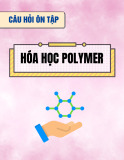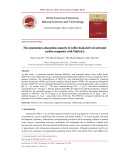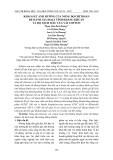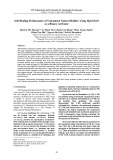
HPU2. Nat. Sci. Tech. Vol 02, issue 02 (2023), 68-82
HPU2 Journal of Sciences:
Natural Sciences and Technology
journal homepage: https://sj.hpu2.edu.vn
Article type: Research article
Received date: 20-8-2023 ; Revised date: 31-8-2023 ; Accepted date: 31-8-2023
This is licensed under the CC BY-NC-ND 4.0
The roles of intermediate fluorophores on the optical properties of
bottom-up synthesized carbon nanodots
Duy-Khanh Nguyen
a,*
, Quang-Trung Le
b
, Xuan-Dung Mai
c
, Thanh-Son Le
a
a
Department of Chemistry, Hanoi National University, 334 Nguyen Trai, Hanoi.
b
Department of Chemistry, Chonnam National University, 500-757 Gwangju, Republic of Korea
c
Department of Chemistry Hanoi Pedagogical University 2, 32 Nguyen Van Linh, Phuc Yen, Vinh Phuc, Vietnam
Abstract
Carbon nanodots (CNDs) are the latest nano-sized carbon materials having unique properties such as
biocompatible, highly photoluminescent, and nontoxic which are suitable for diverse applications
including lighting, sensing, bioimaging, and biochemical analyzing. CNDs could be synthesized by
top-down methods in which graphite is fragmented into nano-sized graphene dots. Alternatively,
CNDs could be formed by a bottom-up synthetic strategy where organic molecules are fused together
via complex condensation and carbonization processes. Although a great number of organic molecules
have been used successfully to prepare CNDs there are very few CNDs that exhibit the quantum size
effects. The absorption and emission properties of bottom-up synthesized CNDs rely vastly on
molecular-like fluorophores which are the intermediates formed during the fusion of molecular
precursors and are incorporated into CNDs in the later states of carbonization processes. This review
aims to demonstrate recent understandings on the formation of intermediate fluorophores and their
contribution to the optical properties of CNDs.
Keywords: Carbon nanodots, Carbon quantum dots, Bottom-up, Fluorophore, Mechanism.
1. Introduction
Inorganic quantum dots (QDs) such as CdX and PbX (X=S, Se, Te) provide fine-tunable nano-
sized building units for the construction of diverse nanoarchitectures for a wide range of applications
including (but not limited to) solution-processed optoelectronics, fluorescence-based sensors, and
* Corresponding author, E-mail: ndkhanhn4o@gmail.com
https://doi.org/10.56764/hpu2.jos.2023.2.2.68-82

HPU2. Nat. Sci. Tech. 2023, 2(2), 68-82
https://sj.hpu2.edu.vn 69
fluorescence-based probes. However, the inherent toxicity related to heavy metals inhibits their
practical applications, especially in bio-related fields [1]. Therefore, the development of biocompatible
QDs have been strongly demanded to replace Cd-based QDs in various biological and medical
applications. Since the first report in 2004 [2] water-soluble and fluorescent carbon nanodots (CNDs)
have attracted increasing researches that have now described CNDs to be low-toxicity [3], tunable
emission color in the visible and near infrared regions [4], low cost [5], [6], and applicable to diverse
fields including light-emitting diodes (LEDs), photocatalyst, bioimaging, and sensing. Nevertheless,
the chemical structure and luminescent mechanism of CNDs are still not fully understood. In this
review, we will address the recent understandings on the structure of CNDs as well as the contribution
of molecular-like fluorophores to the optical properties of CNDs. We indeed hope that this review can
provide understandings on the relation between the chemical structure and the optical properties of
CNDs, especially bottom-up synthesized CNDs that could help ones to design CNDs for target
applications.
2. The evolution of the structure of bottom-up synthesized carbon nanodots
Carbon nanodots (CNDs) or carbon quantum dots (CQDs) were fist observed by X. Xu and
coworkers as fluorescent nanoparticles when they purified carbon nanotube from arc-discharge soot
[2]. The fact that the aqueous solutions of nanoparticles exhibit intense luminescence in the visible
region has attracted increasing scientists to explore CNDs in diverse aspects with the hope to replace
Cd-based quantum dots in many applications where the toxicity of materials is concerned. CNDs
became a new member of zero-dimensional carbon nanomaterials as shown in Fig. 1 [7]. The structure
of a CDN was modeled as an assembly of polycyclic aromatic hydrocarbons (PAHs) attracting
together via π-π interactions or being embedded in a carbogenic matrix, Fig. 2a [8]. PAHs alone surely
follow the quantum confinement effects, i.e. the energy gap decreases as the size of PAH increases.
Therefore, when CNDs compose of a few layers of PAHs, which are usually named as graphene
quantum dots, the CNDs will exhibit the quantum size effects, e.g. the emission color red-shifts as the
diameter of CNDs increases, Fig. 2b [9], [10]. Shuit-Tong Lee group used an electrochemical
oxidation method to cut graphite rod into CNDs having a diameter ranging from 1.2 to 3.8 nm and
demonstrated size-dependent fluorescence [11]. Recently, F. Yuan and co-workers demonstrated that
triangular CNDs prepared by hydrothermal treatment of phloroglucinol exhibited narrow emission
spectra and quantum size effects [12].

HPU2. Nat. Sci. Tech. 2023, 2(2)
,
68-82
https://sj.hpu2.edu.vn 70
Figure 1: The classification of carbon nanomaterials according to the dimensionality. Carbon
nanodots is a new member of 0D dimensional carbon nanomaterials in which the charges are confined
in all three dimensions [7].
Figure 2: a) Schematic structure of a carbon nanodots; b) The size-dependent energy levels of
graphitic carbon nanodots [9].

HPU2. Nat. Sci. Tech. 2023, 2(2)
,
68-82
https://sj.hpu2.edu.vn 71
In the cases of inorganic quantum dots such as CdX and PbX (X=S, Se, Te) the capping ligand
could be exchanged from one to another to tune the solubility while almost maintaining the band gap
of the dots. One of striking characters of CNDs is that their electronic structure is strongly influenced
by the surficial functional groups, especially in the cases that CNDs have one graphitic layer [13]. S.
Jeon observed that the bandgap of CNDs synthesized from graphene oxide decreased with increasing
the number of amino functional groups [14]. The effects of the functional groups could be understood
from DFT calculations based on naphthalene model shown in Fig. 3. Both –CHO and –NH
2
change
significantly the HOMO and LUMO energy levels because the conjugation system which is regarded
as the confinement space of PAH extends to the functional groups. Because of the covalence bonds
between PAH and surficial groups the confinement space needs to be treated not only PAH but also
the surface groups. The absorption and emission of CNDs that involve orbitals influenced by surficial
groups such as HOMO and LUMO shown in Fig. 3 are affected by solvation medium due to the local
interactions between solvent molecules and the functional groups, Fig. 4 [15], [16] .
Figure 3: Effects of functional groups and solvation medium on the energy levels. DFT calculations
were conducted on naphthalene model using B3LYP function using 6.31g basic set. –CHO and –NH
2
were used as functional groups.
Figure 4: a) Normalized emission spectra of CNDs dissolved in different solvents. Adapted with
permission from ref [15], Copyright 2016, American Chemical Society. b) Effects of solvent polarity
parameter (E
T
(30) on the emission energy of CNDs synthesized from (a): o-phenylenediamine, (b): m-
phenylenediamine, and (c): p-phenylenediamine [16].

HPU2. Nat. Sci. Tech. 2023, 2(2)
,
68-82
https://sj.hpu2.edu.vn 72
Figure 5: The excitation dependence of photoluminescence of CNDs is attributed to the energy
transferring among PAHs within CNDs. Adapted with permission from ref [8], Copyright 2015,
American Chemical Society.
Figure 6: a) The contribution of molecular fluorophore (blue) and carbogenic core (black) to the
emission of CNDs obtained at different pyrolysis temperature. Adapted with permission from ref [17],
Copyright 2012, American Chemical Society. b) IPCA fluorophore accounts for the high
photoluminescence of CNDs synthesized from citric acid and amines. Adapted with permission from
ref [18], Copyright 2016, American Chemical Society. c) Molecular dynamics shows the self-
assembling of IPCA and PAHs into quasi-spherical CNDs in an aqueous medium. Reprinted with
permission from ref [19]. Copyright 2021 Elsevier.
In addition to contribution of surficial groups to the optical properties of CNDs the interactions
among PAHs within CNDs that could even lead to ultimate orbital hybridizations [20] make the
electronic transitions within a CND be more complicated. M. Fu and coworkers demonstrated that a
physical mixture of anthracene, pyrene, and perylene exhibited excitation-dependent
photoluminescence that was similar to CNDs synthesized from citric acid (CA) and ethylenediamine
(EDA) [8]. The authors explained the excitation dependence of CNDs to be due to the fact that subsets
of PAHs can be excited at different wavelength and the resultant excitons migrate to the larger PAHs,
Fig. 5.
In parallel to top-down synthetic strategy, there have been number of methods to prepare CNDs
using molecular precursors which could be either pure chemicals or components extracted from















![Ô nhiễm không khí từ nông nghiệp: Thách thức toàn cầu và định hướng hành động [Mới nhất]](https://cdn.tailieu.vn/images/document/thumbnail/2025/20250917/kimphuong1001/135x160/52891758099584.jpg)










